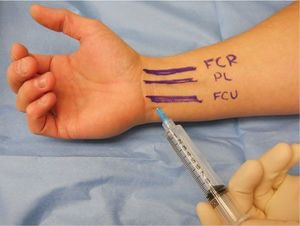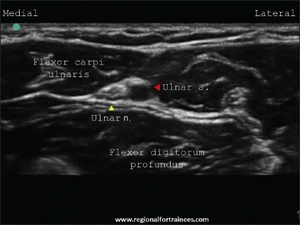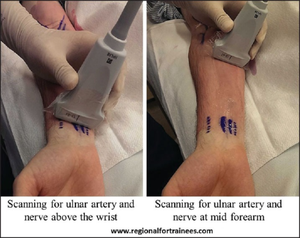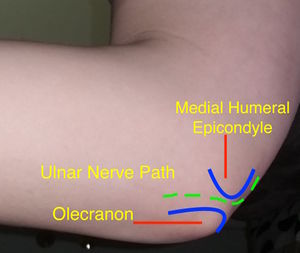We need you! Join our contributor community and become a WikEM editor through our open and transparent promotion process.
Nerve Block: Ulnar Nerve
From WikEM
Contents
Background
- Ulnar nerve block is a quick, safe, and effective means of pain reduction for hand injuries, including reduction of Boxer's Fracture[1]
Indications
- Boxer's Fracture
- Hand Burns
- Complex Hand Injury
- Need for pain control or to perform painful procedure in distribution of ulnar nerve
Contraindications
- Infection overlying injection site
Equipment Needed
- 10 cc Syringe with a 27 Gauge Needle
- Blunt fill needle (to draw up anesthetic)
- Local Anesthetic (e.g. Lidocaine or Bupivacaine)
- Antiseptic (e.g. Chlorhexidine, Betadine)
- Sterile Gloves
- Sterile Drape and sterile ultrasound probe cover
- Linear Ultrasound Probe
Wrist Block Procedure
- Obtain informed consent
- Patient should be made aware that they will lose both sensory and motor function of the ulnar distribution until the anesthetic wears off
- Place the patient's extremity in the supinated position
- Cleanse the skin with chosen antiseptic
- Create a sterile field using sterile drape
- In a sterile fashion, apply a small wheel of local anesthetic to the area immediately medial to tendon of the Flexor Carpi Ulnaris and approximately 2 cm proximal to the wrist crease.
- The ulnar nerve should be immediately deep to the Flexor Carpi Ulnaris Tendon
Non-Ultrasound Guided Technique
- Direct the Needle radially, deep to the Flexor Carpi Ulnaris
- The ulnar nerve is ulnar in relation to the ulnar artery; even still, it is important to aspirate prior to injecting anesthetic to rule out intra-arterial placement
- Discontinue and reposition should the patient report shooting "electrical" pains or numbness prior to injection
- Inject approximately 5 mL of local anesthetic
Ultrasound Guided Technique
- Have a partner help place the Linear Ultrasound Probe into the Sterile Probe Cover
- Starting mid forearm of the volar aspect in a transverse plane, locate the Ulnar Nerve
- Sliding Distally, the Ulnar Nerve and Artery should separate from each other
- Injection site is generally approximately 2 cm proximal to the wrist crease.
- In plane, visualize the needle on the Ultrasound monitor as you advance towards the Ulnar Nerve.
- Make sure to aspirate prior to injecting to rule out vascular penetration (low risk given ultrasound guidance)
- Discontinue and reposition should the patient report shooting "electrical" pains or numbness prior to injection
- Inject approximately 5 mL of local anesthetic in the area immediately surrounding the Ulnar Nerve
Elbow Block Procedure
- Obtain informed consent
- Patient should be made aware that they will lose both sensory and motor function of the ulnar distribution until the anesthetic wears off
- Place the patient's extremity in the supinated position with elbow flexed between 45 & 90 degrees
- Cleanse the skin with chosen antiseptic
- Create a sterile field using sterile drape
- In a sterile fashion, apply a superficial small wheel of local anesthetic to the area proximal to the medial humeral epicondyle
Non-Ultrasound Guided Technique
- Injection site should be chosen approximately 2-3 cm proximal to the sulcus ulnaris groove
- This is done as the ulnar nerve is relatively fixed in the tight groove and it is important to minimize risk of direct nerve trauma and neurapraxia due to pressure build up
- Direct the needle cephalad at 45 degrees[2]
- Aspirate prior to injection to rule out intravascular placement
- Discontinue and reposition should the patient report shooting "electrical" pains or numbness prior to injection
- Inject approximately 3-5 mL of local anesthetic
Complications
- Inadvertent intravascular injection
- Infection
- Bleeding/hematoma
- Neurapraxia
See Also
External Links
References
- ↑ Ünlüer, EE. Ultrasound-guided Ulnar Nerve Block For Boxers Fractures. Am.J.Emerg.Med. 2016;34(8):1726.
- ↑ McCahon, RA et al. Peripheral nerve block at the elbow and wrist. Contin Educ Anaesth Crit Care Pain (2007) 7 (2): 42-44.




